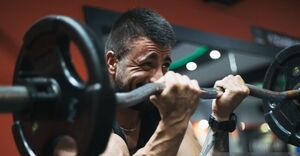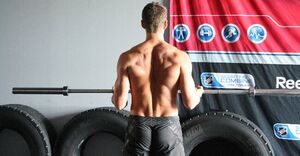
Building Sculpted Shoulders: Professional Dumbbell Training Techniques Unveiled
Are you looking to build strong and sculpted shoulders? Dumbbell training could be the key to achieving your fitness goals.
In this article, we will explore the benefits of dumbbell training for shoulders and provide you with a range of basic and advanced exercises to help you build muscle.
We will also delve into creating a dumbbell shoulder workout plan, including how many sets and reps you should do, how often you should train your shoulders, and how to progress in your training.
We will share some tips and tricks for maximizing your dumbbell shoulder training, including proper form and technique, choosing the right weight, and the importance of rest and recovery.
If you’re ready to take your shoulder training to the next level, keep reading to discover the professional dumbbell training techniques that will help you achieve the sculpted shoulders you’ve always wanted.
Why Focus on Dumbbell Training for Shoulders?
Focusing on dumbbell training for shoulders is a professional approach to building sculpted shoulders and enhancing overall strength and fitness. As one of the most effective techniques unveiled in the fitness world, dumbbell training offers targeted exercise for shoulder muscles, aiding in the development of a comprehensive workout routine.
The use of dumbbells allows for a wide range of shoulder exercises. These include lateral raises, front raises, shoulder presses, and reverse flyes, which engage various muscles in the shoulders, such as the deltoids and trapezius.
This targeted approach not only helps in sculpting the shoulders but also strengthens the stabilizing muscles. This promotes better posture and reduces the risk of injury. Incorporating dumbbell training for shoulders into a regular workout regimen can contribute to improved overall upper body strength and enhanced athletic performance.
What Are the Benefits of Dumbbell Training for Shoulders?
The benefits of dumbbell training for shoulders are multifaceted, encompassing targeted exercises such as shoulder press, lateral raises, and front raises to engage the deltoids and other crucial shoulder muscles. This approach aids in effective bodybuilding and muscle development, contributing to overall strength and fitness.
These exercises effectively target the three heads of the deltoid muscles, helping to sculpt and define the shoulders.
Shoulder press, in particular, is a compound movement that not only works the deltoids but also engages the triceps and upper chest, promoting balanced muscle development.
Lateral raises and front raises isolate the deltoids, enhancing their strength and definition, which is vital for both aesthetic purposes and functional movement.
Basic Dumbbell Exercises for Building Shoulder Muscles
Basic dumbbell exercises for building shoulder muscles lay the foundation for targeted development, featuring prominent techniques such as dumbbell shoulder press, lateral raises, and front raises. These exercises are fundamental to sculpting and strengthening the shoulder muscles, providing essential building blocks for comprehensive shoulder workouts.
The dumbbell shoulder press is a powerful exercise that targets the entire shoulder region, including the front, side, and rear deltoids. As you raise the dumbbells overhead, focus on engaging the shoulder muscles while maintaining proper form to maximize results.
Lateral raises are ideal for isolating the side deltoids, enhancing shoulder width and stability. Similarly, front raises primarily work the front deltoids, contributing to balanced shoulder development. Incorporating these exercises into your routine can lead to improved shoulder strength, stability, and aesthetics.
Dumbbell Shoulder Press
The dumbbell shoulder press is a pivotal exercise for enhancing shoulder strength and stability. It requires precise exercise technique and muscle endurance, making it a cornerstone of effective shoulder training.
Proper weight selection is vital to optimize the impact of this exercise on shoulder muscles. The dumbbell shoulder press is an effective exercise for engaging the deltoid muscles and providing a comprehensive shoulder workout. It’s important to maintain proper form, including a neutral spine and controlled movements, to avoid injury and maximize effectiveness.
Gradually increasing the weight and adjusting the range of motion can help improve muscle endurance and overall strength. Incorporating variations, such as seated or standing presses, can further target specific areas and prevent plateauing in progress. By integrating the dumbbell shoulder press into a well-rounded workout routine, individuals can achieve balanced shoulder development and functional strength.
Dumbbell Lateral Raise
Dumbbell lateral raises are instrumental for targeted muscle activation in the shoulders, necessitating a balanced approach to exercise frequency and progressive overload.
Proper recovery strategies contribute to maximizing the impact of this exercise on muscle development, making it a valuable component of shoulder training regimens.
Incorporating dumbbell lateral raises into a workout routine can effectively engage the deltoid muscles and promote strength and stability in the shoulders.
To achieve optimal results, it’s important to balance exercise frequency and allow for adequate rest between sessions to promote muscle recovery and growth. Progressive overload techniques, such as gradually increasing weights, can further stimulate muscle adaptation and hypertrophy.
It’s crucial to incorporate ample rest and recovery time between workouts to prevent overtraining and ensure sustainable muscle development.
Dumbbell Front Raise
Dumbbell front raises contribute to targeted muscle fatigue in the shoulders while emphasizing a comprehensive range of motion and exercise variation. The resulting muscle pump from this exercise underscores its relevance in diversifying shoulder workouts and promoting muscle development.
This exercise targets the anterior deltoids, with the dynamic movement recruiting other shoulder stabilizing muscles as well.
Engaging in a complete range of motion ensures that the entire shoulder girdle is activated, promoting balanced muscle development.
Varying the exercise by altering grip, hand position, or incorporating pauses can further intensify the muscle recruitment and enhance overall shoulder strength.
Incorporating these diverse exercise variations can also help prevent muscle adaptation, maximizing the effectiveness of the workout.
Dumbbell Rear Delt Fly
Incorporating dumbbell rear delt fly exercises into shoulder training contributes to effective shoulder injury prevention by enhancing mobility, stability, and overall shoulder health. This exercise focuses on strengthening crucial shoulder attributes, laying the groundwork for a holistic approach to shoulder fitness.
The dumbbell rear delt fly engages the rear deltoid muscles, stabilizing the shoulder joint and reducing the risk of imbalances and injuries. This exercise also improves shoulder mobility by targeting the muscles responsible for arm movements.
Strengthening these muscles can alleviate stress on the shoulder joint, promoting better overall shoulder health and functionality. Regularly including this exercise in a well-rounded workout routine can help prevent shoulder-related issues and maintain optimal shoulder performance.
Advanced Dumbbell Exercises for Building Shoulder Muscles
Advanced dumbbell exercises for building shoulder muscles introduce specialized techniques such as dumbbell Arnold press, upright rows, and shrugs, offering a more intricate approach to targeting shoulder development. These exercises elevate the intensity of shoulder training, catering to individuals seeking advanced shoulder workout methods.
The dumbbell Arnold press engages the entire shoulder complex with its rotational movement, promoting balanced muscle growth and stability. Upright rows effectively target the deltoid muscles, resulting in broader and more defined shoulders.
Incorporating shrugs into your routine can strengthen the trapezius muscles, improving posture and overall shoulder stability. These advanced exercises not only aid in muscle building, but also enhance shoulder strength and functionality for daily activities.
Dumbbell Arnold Press
The dumbbell Arnold press represents a dynamic exercise that combines exercise variation, isolation, and compound movements to bolster shoulder strength and stability. This multifaceted exercise provides a unique approach to shoulder training, emphasizing comprehensive muscle engagement and development.
By incorporating exercise variation, the Arnold press targets different areas of the shoulder muscles, promoting balanced development. Its integration of isolation exercises allows for focused attention on the deltoids, enhancing their definition and strength.
The compound movements involved recruit stabilizing muscles, fostering overall shoulder stability. This exercise’s versatility makes it an essential component of any comprehensive shoulder workout routine, facilitating both strength and function.
Dumbbell Upright Row
The dumbbell upright row demands precise exercise technique, emphasizing muscle endurance and strategic weight selection to optimize the exercise’s impact on shoulder muscles.
Balancing exercise frequency is crucial to harness the full potential of this advanced shoulder training method. Proper form and control are essential when performing the dumbbell upright row to effectively target the deltoids, trapezius, and other supporting muscles. It’s important to choose a weight that challenges you while still allowing for controlled repetitions, as this exercise is geared towards endurance.
To see the best results, it’s recommended to incorporate the dumbbell upright row into a comprehensive shoulder workout routine, aiming for 2-3 sessions per week to allow for proper rest and recovery. Additionally, gradually increasing the weight and varying the grip can further enhance shoulder muscle development and overall strength.
Dumbbell Shrugs
Dumbbell shrugs are instrumental in promoting muscle hypertrophy through a comprehensive range of motion and exercise variation, necessitating substantial muscle endurance for optimal results. This exercise offers an advanced approach to enhancing shoulder strength and overall development.
The range of motion in dumbbell shrugs targets the upper trapezius muscles, resulting in significant muscle hypertrophy. Incorporating variations such as single-arm dumbbell shrugs or rotational shrugs can further stimulate muscle growth and strength.
By challenging the muscles with different movements, this exercise helps prevent plateauing and constantly engages the muscle fibers. This continuous variation is essential for sustained muscle growth and development, making dumbbell shrugs a key element in any hypertrophy-focused training regimen.
Creating a Dumbbell Shoulder Workout Plan
Creating a comprehensive dumbbell shoulder workout plan involves integrating strength training, emphasizing proper exercise form, and optimizing training intensity to ensure effective muscle activation. This strategic approach forms the basis of a structured shoulder workout regimen, tailored to individual fitness goals.
Strength training is a key way to target and strengthen shoulder muscles, including the deltoids, while also building overall upper body strength. Proper exercise form is crucial for preventing injury and effectively engaging targeted muscles during each movement.
Incorporating progressive overload, such as heavier weights and challenging variations, is essential for optimizing training intensity and promoting continuous strength and muscle development. These foundational principles are key components of a highly effective dumbbell shoulder workout plan.
How Many Sets and Reps Should You Do?
Determining the appropriate sets and reps for dumbbell shoulder exercises involves balancing exercise frequency, progressive overload strategies, and effective muscle recovery to mitigate muscle fatigue.
Tailoring the sets and reps to individual capacity is crucial for optimizing shoulder training results.
Progressive overload strategies for shoulder exercises can be effectively implemented by gradually increasing resistance or repetitions. It’s important to also incorporate adequate rest periods between sets and vary rep ranges to prevent overtraining and support muscle recovery.
Paying attention to signs of muscle fatigue and adjusting sets and reps accordingly is crucial for promoting optimum shoulder muscle growth and strength development.
How Often Should You Train Your Shoulders?
Establishing the optimal frequency for shoulder training involves aligning with a structured fitness regimen, ensuring the integration of a cohesive exercise program and workout routine for comprehensive muscle endurance and development.
Incorporating a variety of shoulder exercises into your fitness regimen can effectively target different areas of the shoulder muscles. These exercises include overhead presses, lateral raises, and rear delt flys.
Varying the intensity and volume of your shoulder workouts within your exercise program can help prevent plateaus and encourage continual muscle growth. It’s important to adjust the frequency of shoulder training according to individual recovery capabilities, and to prioritize rest and proper nutrition to support the demands of a challenging workout routine.
How to Progress in Your Dumbbell Shoulder Training?
Progressing in dumbbell shoulder training involves a systematic approach to strength training, refining exercise techniques, prioritizing muscle recovery, and implementing progressive overload strategies. This tailored progression is essential for maximizing the impact of shoulder training on overall strength and fitness.
When it comes to shoulder exercises, it’s important to gradually increase weight and resistance to keep challenging and stimulating muscle growth. A variety of exercises, including shoulder presses, lateral raises, and upright rows, can effectively target different parts of the shoulder muscles. It’s crucial to maintain proper form and technique to prevent injuries and maximize gains. With consistent application of progressive overload principles, individuals can expect noticeable improvements in shoulder strength and muscle endurance over time.
Tips and Tricks for Maximizing Your Dumbbell Shoulder Training
Maximizing the effectiveness of dumbbell shoulder training involves optimal strategies for weightlifting, harnessing the benefits of resistance training, and strategic exercise selection to target specific shoulder muscle groups. These tips and tricks contribute to refining the overall quality of shoulder workouts.
To achieve a well-rounded shoulder workout, it’s important to incorporate a variety of shoulder-specific exercises. These can include overhead presses, lateral raises, and front raises, which engage different parts of the shoulders and promote balanced development.
Proper form and controlled movements are crucial in maximizing the benefits of dumbbell shoulder training. This not only reduces the risk of injury but also enhances muscle engagement, resulting in more efficient and effective workouts.
Proper Form and Technique
Emphasizing proper form and technique in dumbbell shoulder exercises is paramount for enhancing muscle endurance, optimizing weight selection, and balancing exercise frequency to attain optimal training results.
This focus on form contributes to the overall effectiveness of shoulder workouts. Proper form is essential for preventing injuries and engaging the targeted muscles fully during exercise. It also helps maintain stability and control, improving overall coordination and balance. Using proper technique in dumbbell shoulder exercises leads to smoother execution and reduces strain on other muscle groups. This promotes a more balanced and symmetrical physique, as each shoulder receives equal attention and effort. These factors contribute to significant improvements in strength and muscle development, making workouts more productive and rewarding.
Choosing the Right Weight
Selecting the appropriate weight for dumbbell shoulder exercises involves considerations of progressive overload, strategies for muscle recovery, mitigating muscle fatigue, and ensuring a complete range of motion. Choosing the right weight is pivotal for optimizing the effectiveness of shoulder training.
Progressive overload is crucial for muscle growth. It involves gradually increasing weight to continuously challenge the muscles, stimulating adaptation and development. Prioritizing muscle recovery through rest, nutrition, and foam rolling can reduce the risk of overtraining.
When performing shoulder exercises, it’s essential to manage muscle fatigue. This can be achieved by varying training intensity, maintaining proper form, and taking adequate rest periods between sets to maintain optimal performance throughout the workout.
Rest and Recovery
Ensuring adequate rest and recovery in between dumbbell shoulder training sessions is essential for managing exercise frequency, optimizing muscle recovery, alleviating muscle soreness, and harnessing the benefits of muscle pump.
This emphasis on rest and recovery contributes to the overall efficacy of shoulder workouts. Proper rest is crucial for muscle development. It allows the muscles to repair, grow, and adapt to the stress placed on them during workouts. Adequate rest between sessions enables individuals to train with higher frequency and intensity, leading to enhanced muscle development.
In addition, taking breaks between workouts helps reduce the risk of overtraining. Overtraining can impede progress and increase the likelihood of injury, so it’s important to give your body enough time to recover. Sufficient recovery periods also enhance the muscle pump effect, promoting better blood flow and nutrient delivery to the shoulders. This ultimately supports their growth and strength.




No Comments